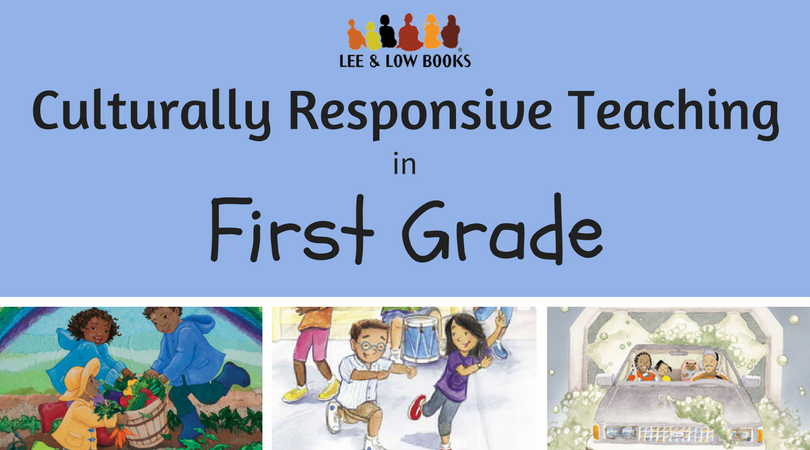In this ongoing series, we explore what culturally responsive teaching looks like at different grade levels and offer concrete examples and resources. Last month we explored ideas for read alouds that build relationships in Kindergarten. This month, educator Lindsay Barrett offers guidance on culturally responsive teaching in grade 1 through the intentional selection of texts for reading instruction.

First grade is a transitional year in many ways. Students arrive displaying the innocent, literal thinking reminiscent of Kindergarten and grow to be more aware, critical thinkers—often with a few new permanent front teeth! While read aloud is still a crucial aspect of the curriculum (find many text selections and lesson plans here and here), first grade is also when many students make the leap to independent reading. How can teachers help students actively dig into grade level reading? Selecting instructional texts using a culturally responsive lens is one important strategy. (What is culturally responsive teaching? Check out this post.)
One way to draw first graders into classroom reading instruction is to rethink your sources for shared reading material. Supplement your collection of traditional nursery rhymes and tried-and-true favorite poems with selections that reflect your students’ lives. Pencil Talk and Other School Poems includes students of diverse  backgrounds in the illustrations and touches on themes relevant to many students (e.g. “Why can’t recess last all day?”) Excerpts from the classic Bein’ With You This Way not only celebrate diversity but also offer the chance to discuss how speech patterns can be recorded and honored in written text (“Big nose. Little nose. Straight hair. Curly hair. Different—Mm-mmm, but the same, Ah-ha!”)
backgrounds in the illustrations and touches on themes relevant to many students (e.g. “Why can’t recess last all day?”) Excerpts from the classic Bein’ With You This Way not only celebrate diversity but also offer the chance to discuss how speech patterns can be recorded and honored in written text (“Big nose. Little nose. Straight hair. Curly hair. Different—Mm-mmm, but the same, Ah-ha!”)
Selecting culturally responsive texts for small group reading instruction is another opportunity to engage students. In her article for “Rethinking Schools,” educator Sandra Osorio encourages teachers to choose text sets that reflect not just students’ appearances but cultural backgrounds and experiences as well. She shares her personal journey to compile text sets that resonated with her largely bilingual, bicultural student population and the increase in engagement she observed when she found texts that were a good match. This is consistent with leading research on student motivation; John T. Guthrie and colleagues have written extensively about how access to reading material relevant to their lives builds students’ intrinsic motivation to read, which in turn boosts reading achievement. (Guthrie’s work is parallel in many ways to the tenets of culturally responsive teaching.)
Seek out books that portray topics or settings to which your students can relate and look for illustrations that depict characters that reflect their backgrounds. From simple texts like Best Friends, which depicts Asian Indian buddies swimming and playing at the park, to high-interest texts for independent readers like At the Firehouse With Dad, Bebop Books allow students to see themselves in books. Spanish versions are also available. The Confetti Kids series portrays a diverse group of children who grapple with common childhood issues like moving to a new home and deciding what to play with friends.
in books. Spanish versions are also available. The Confetti Kids series portrays a diverse group of children who grapple with common childhood issues like moving to a new home and deciding what to play with friends.
Sandra Osorio also shares how she learned to quiet her standards-driven urge to “move things along” and make time and space for student discussion about personal connections to texts. Early reading instruction often focuses on “making it through” the text with a certain accuracy percentage or fluency rate. Even though sometimes your instinct (and your students’) may be to breathe a sigh of relief when a book is finished and set it aside, don’t miss out on the opportunity to engage students in meaningful conversation.
Admittedly, it can be difficult to construct meaty questions about early reading texts. For the very earliest of levels, use the illustrations to spark discussion. For instance, the illustrations of Cleaning Day add to the simple text by showing how the family dog adds to the mess:
Even shared reading texts can spark meaningful discussion. After reading Rainbow Stew as a read aloud, use excerpts as shared reading material. Ask students to reflect on the rich descriptive language (“Slip, slide, squishy stride, we snip off red tomatoes”) to answer “What are you imagining when you read this part?” and use the text as a springboard to discuss sustainable living, reframing disappointing situations in a positive light, and strengthening family bonds.
First grade is undoubtedly a year for solidifying foundational skills and diving into the mechanics of reading. But it’s also a year for children to begin to meaningfully engage in independent reading. Providing culturally relevant texts can be the perfect invitation for them to sink their (new) teeth in.
 About the Author: Lindsay Barrett is a former elementary teacher and literacy nonprofit director. She currently works as a literacy consultant and stays busy raising three young boys. Find out more about her work at lindsay-barrett.com.
About the Author: Lindsay Barrett is a former elementary teacher and literacy nonprofit director. She currently works as a literacy consultant and stays busy raising three young boys. Find out more about her work at lindsay-barrett.com.









